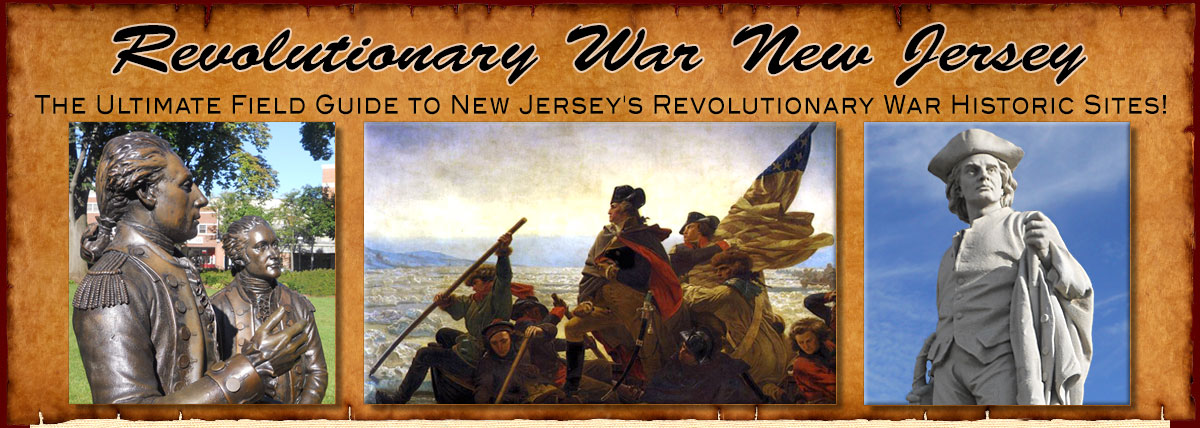

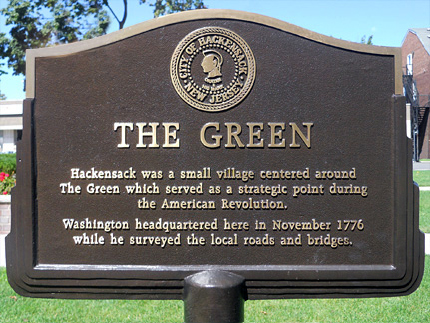
The Green
Main St. and Court St.
Map / Directions to the Hackensack Revolutionary War Sites
The Green, which dates from 1696, [1] and the area surrounding it, were the scene of several important Revolutionary War events, which are detailed in the entries below on this page.

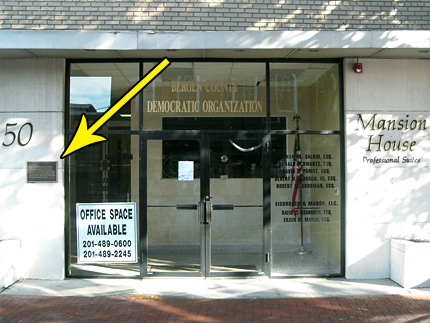
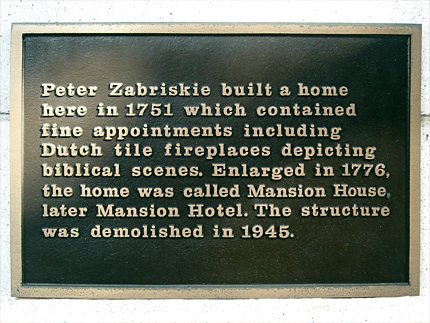
Mansion House
50 Main St. / across from the Green
From November 13 - 21, 1776, George Washington made his headquarters at the home of Peter Zabriskie, known as Mansion House, which stood at this location. At the time, American troops were encamped ten miles from here at Fort Lee. On the morning of November 20, Washington received news at the Zabriskie house that British and Hessian troops had crossed the Hudson River, threatening the American troops at Fort Lee. He ordered the immediate evacuation of the encampment at Fort Lee, which began a long retreat across New Jersey. By that evening, the American troops at Fort Lee had made it as far as Hackensack, where they spent the night before moving on the next morning, and where General Washington spent a final night at Zabriskie's home. [2] An eyewitness account from a resident of Hackensack described the scene of that evening: [3]
"After the evacuation of Fort Lee in Nov., 1776, and the surrender of Fort Washington to the British, Washington at the head of his army, consisting only of about 3,000 men, having sent on his baggage to Acquackanonck, crossed the New Bridge into the town. It was about dusk when the head of the troops entered Hackensack. The night was dark, cold, and rainy, but I had a fair view of them from the light of the windows, as they passed on our side of the street. They marched two abreast, looked ragged, some without a shoe to their feet, and most of them wrapped in their blankets. Washington then, and for some time previous, had his head-quarters at the residence of Mr. Peter Zabriskie, a private house, the supplies for the general's table being furnished by Mr. Archibald Campbell, the tavern-keeper. The next evening, after the Americans had passed through, the British were encamped on the opposite side of the river. We could see their fires about 100 yards apart, gleaming brilliantly in the gloom of night, extending some distance below the town, and more than a mile up toward the New Bridge. Washington was still at his quarters and had with him his suite, life-guards, a company of foot [soldier], a regiment of cavalry, and some soldiers from the rear of the army."
The office building that now stands at 50 Main St. has a historic marker identifying it as the location of the home of Peter Zabriskie. Zabriskie's house was built in 1751 and enlarged in 1776. It was torn down in 1945. [4]

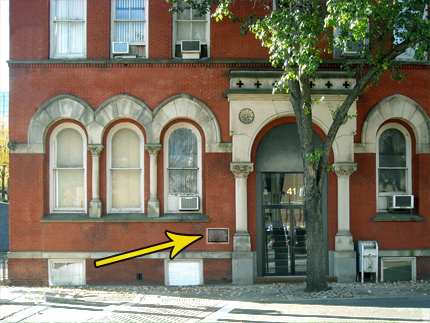
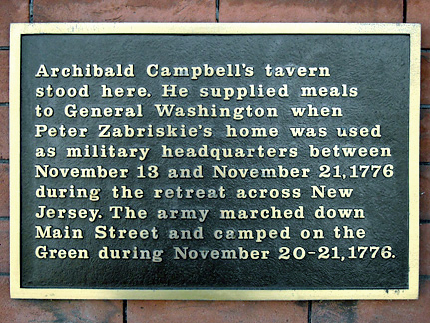
Archibald Campbell's Tavern Site
41 Main St. / across from the Green
While Washington was headquartered at Peter Zabriskie's house (see above entry), meals were supplied to him from the tavern of Archibald Campbell. Campbell was born in 1730 on the Isle of Man; he immigrated to Hackensack in 1765.
On March 23, 1780, Campbell was taken prisoner in a British raid on Hackensack but managed to escape. (See Site of the Burned Courthouse and Jail entry lower on this page.)
Campbell died December 29, 1798, age 68. He is buried in the First Reformed Church cemetery. (See entry lower on this page.) [5]
The building which contained Archibald Campbell's tavern was demolished in September 1873, replaced by the brick building which currently stands here. [6] There is a plaque on the front of the building to mark the site.

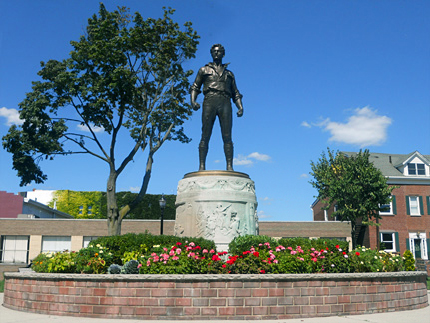
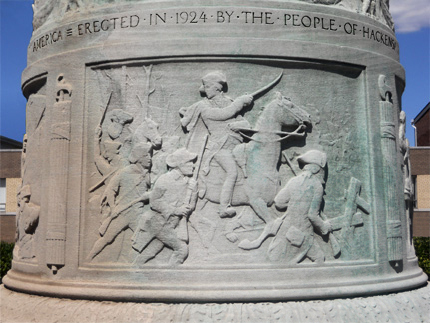
Hackensack War Memorial
Within the Green
Hackensack War Memorial stands in the center of the Green. The base of the monument has four bas relief sculptures of war scenes. The one at the front of the monument is a Revolutionary War scene depicting General Washington at the Battle of Monmouth, an important battle which occurred in Monmouth County, NJ on June 28, 1778. The other three panels represent the Civil War, The Spanish-American War, and World War I. The monument was sculpted in 1924 by Charles Henry Niehaus (1855-1935). [7]

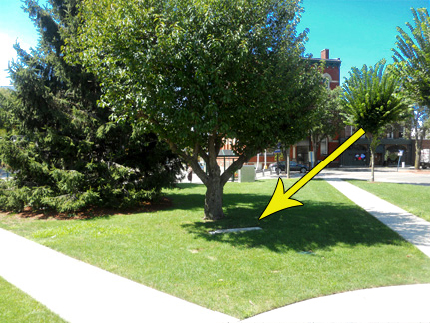
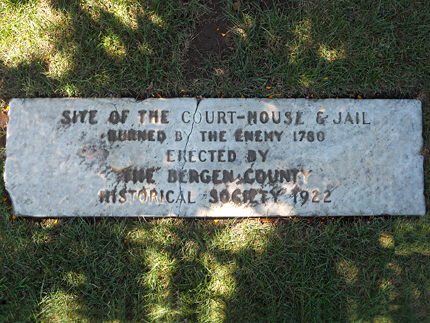
Site of the Burned Courthouse and Jail
Within The Green
On the evening of March 22, 1780, a group of approximately 400 British and Hessian soldiers crossed the Hudson River from New York. Heading to attack American troops at Paramus, they passed through Hackensack around 3 a.m. on March 23, where they burned the courthouse and jail, and two houses. An eyewitness account from a resident of Hackensack at the time of the raid stated: [8]
"One half of the enemy marched quietly through. When the rear, consisting mostly of Hessians, arrived, they broke open the doors and windows, robbed and plundered, and took prisoners a few peaceable inhabitants, among whom was Mr. Archibald Campbell. This gentleman, who had been for several weeks confined to his bed with the rheumatism, they forced into the street and compelled to follow them. Often in their rear, they threatened to shoot him if he did not hasten his pace. In the subsequent confusion he escaped and hid in the cellar of a house opposite the New Bridge. He lived until 1798 and never experienced a return of the rheumatism."
A stone plaque on the ground marks the site of the court-house and jail. The plaque, which sits under a tree, is easy to miss if you aren't looking for it. If you stand in front of the Hackensack War Memorial, the courthouse marker is a few yards to your left. [9]

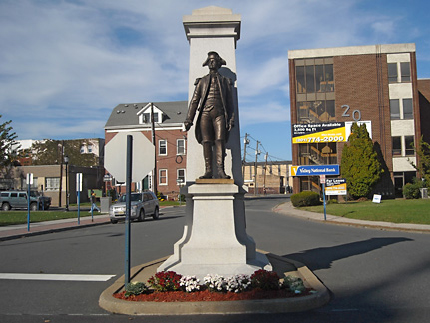
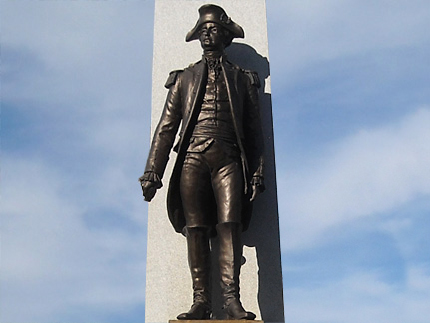
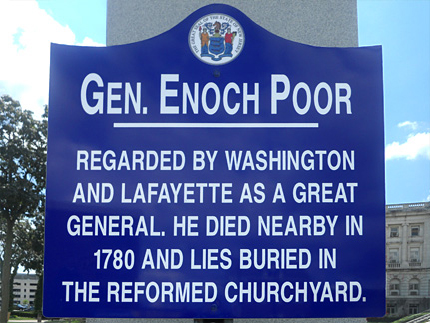
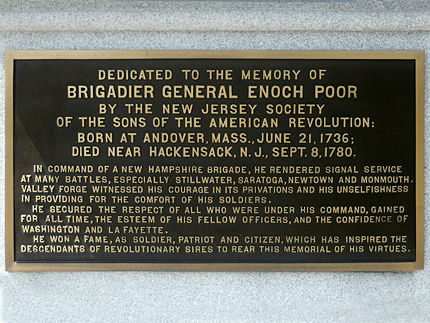
General Enoch Poor Statue
Court St. at Moore St. / across from the Green
General Enoch Poor commanded a New Hampshire Brigade during the Revolutionary War. General Poor died near Hackensack on September 8, 1780. He is is believed to have died of Typhoid Fever. However, there is evidence to suggest that he actually died in a duel with a subordinate officer. He is buried across Moore Street from this statue in the First Reformed Church Cemetery. His funeral was attended by General Washington and General Lafayette. [10]
A week after General Poor's death, Washington wrote of his death in a letter to Congress, stating that Poor was "an officer of distinguished merit, who as a citizen and a soldier, had every claim to the esteem of his country." [11]


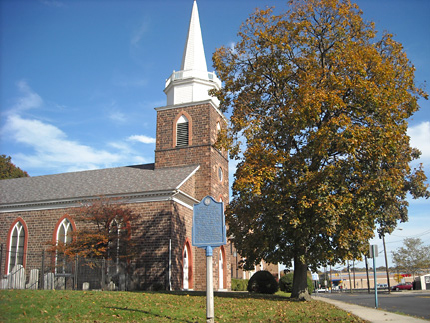
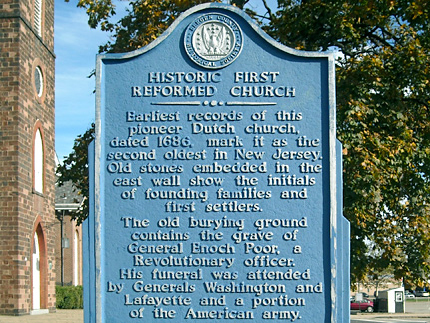
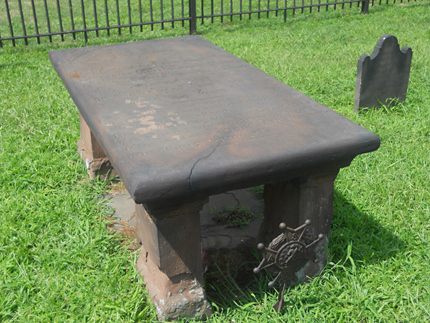
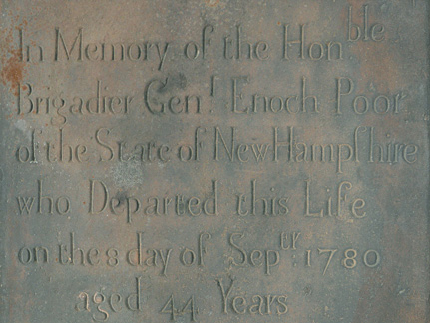
First Reformed Church Cemetery - Gravesite of General Enoch Poor
Court St. at Moore St. / across from the Green
General Enoch Poor is buried in the cemetery of the First Reformed Church, across Moore Street from the statue of him shown in the above entry. His tabletop gravestone reads, "In memory of the Honorable Brigadier Gen. Enoch Poor of the State of New Hampshire who departed this life on the 8th day of Sept. 1780[,] aged 44 years. Washington, Lafayette and a portion of the American army attended the burial of Gen. Poor. In 1824, Lafayette re-visited this grave, and turning away much affected, exclaimed, Ah! that was one of my Generals." [12]
General Lafayette was a French General who fought for the American side in the Revolutionary War. He developed close friendships with Washington, Hamilton, and other Revolutionary War figures. Decades after the end of the War, Lafayette made a return visit from France to the United States from August 16, 1824 - September 7, 1825. At that time, the United States consisted of only 24 states, and Lafayette's trip took him to all of them. Lafayette's visit to Hackensack and this gravesite was on July 14, 1825. He also visited Paterson and Morristown the same day. Other historic sites associated with Lafayette's 1824/1825 visit to America can be found in Elizabeth, Morristown, Newark, Paramus and Woodbridge. [13]
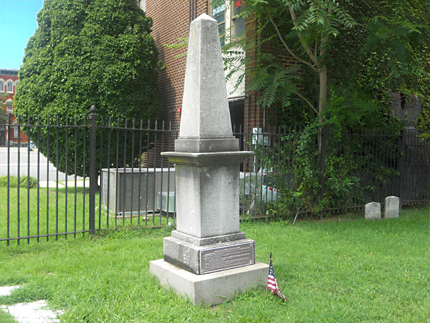
Archibald Campbell Family Monument
Archibald Campbell, who operated the tavern which supplied meals to General Washington's Headquarters in Hackensack in November 1776, is buried here. (See Archibald Campbell's Tavern Site entry above on this page.)
The Archibald Campbell Family Monument pays tribute to Archibald , his wife Catherine, and their five children.
A plaque on the monument reads: [14]
"Archibald Campbell - 1730 - 12/28/1798, age 68. Born on the Isle of Man, came to Hackensack in 1765. Tavern keeper, host to General George Washington, Hackensack's first Postmaster. Exemplary in all the duties of life, a compassionate husband, and affectionate parent, an obliging neighbor and just in all his dealings. It may truly be said he was an honest man. He lived and respected and died lamented by all who knew him."
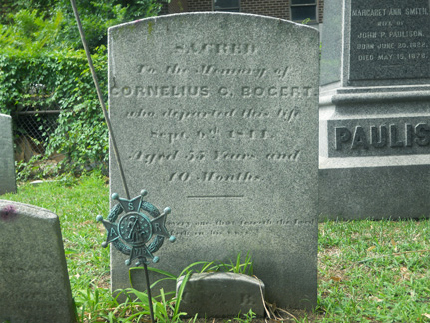
Other Revolutionary War Graves
Revolutionary War Soldiers are buried in this cemetery, including: [15]
Cornelius C. Bogert - Died September 6, 1811; aged 55 and 10 months
Morris Earle
John Van Geson - Died October 1 1823; aged 73 Years and 1 month
Lucas Van Saun - Died March 25, 1812; aged 65 years
Richard Varick (March 25, 1753 - July 30, 1831)
Served as an aide-de-camp to General Washington
Later the Mayor of New York
William Young
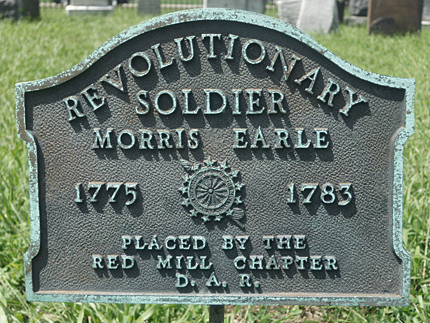
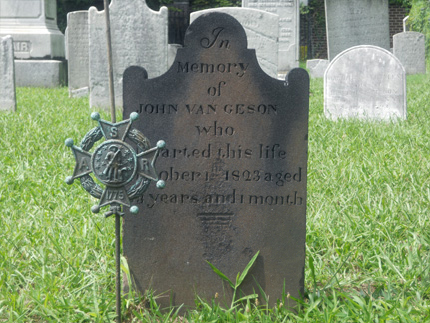


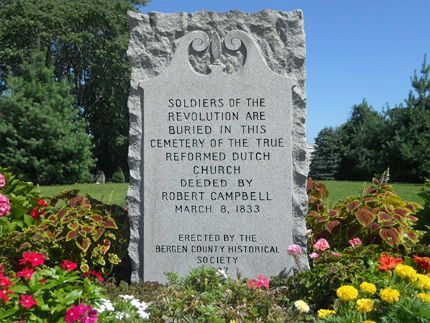
Reformed Dutch Cemetery
Hudson St. between Lafayette St. and Marion. St.
Map / Directions to the Reformed Dutch Cemetery
Map / Directions to the Hackensack Revolutionary War Sites
This cemetery contains the remains of Revolutionary War soldiers. Although no grave markings remain in the field of grass, there is a stone that reads, "Soldiers of the Revolution are buried in this cemetery of the true reformed Dutch church." [16]
Note that the flag in the photo is at half-mast. I happened to shoot these photos days after Neil Armstrong died. Flags throughout the country were at half-mast in honor of the first man to walk on the moon. Since this is a website about New Jersey, it should be noted the second man to walk on the moon, Armstrong's Apollo shipmate Buzz Aldrin, was born and raised in Montclair, New Jersey. [17]

1. ^ • Theodore Bayard Romeyn, Historical Discourse Delivered on Occasion of the Re-opening and Dedication of the First Reformed (Dutch) Church, at Hackensack, N.J.: May 2, 1869 (New York: Board of Publication, R.C.A., 1870) page 44
Available to be read at Google Books here2. ^ David Hackett Fischer, Washington's Crossing (New York; Oxford University Press, 2004) pages 117 - 126
• A note about the distance from Zabriskie's house to the Fort Lee encampment being ten miles:
Using modern roads, the distance today is eight miles. However, in 1776, the journey was longer because it was necessary to use the New Bridge to cross the Hackensack River.3. ^ John Warner Barber, Henry Howe, Historical Collections of the State of New Jersey: Containing a General Collection of the Most Interesting Facts, Traditions, Biographical Sketches, Anecdotes, Etc. Relating to Its History and Antiquities, with Geographical Descriptions of Every Township in the State (New York: S. Tuttle, 1846) Pages 82-83 Available to be read at Google Books here
▸ The authors do not identify the eyewitness by name.
Note that the book was published in 1846, when many eyewitnesses to Revolutionary War events would still have been alive. As the book's preface explains:"In collecting the materials for this work, we have travelled over the State, conversed with her most intelligent citizens, among whom were survivors of the Revolution, and obtained from them descriptions of their respective localities, and many items of historical value. We have, moreover, solicited written communications from gentlemen in all parts of the state, embodying facts of great value, which could be properly prepared only by those who resided on the spot. These solicitations have been met with a promptness altogether unexpected, and the materials thus obtained have much enhanced the value of this publication and placed us under lasting obligations.
"It will be perceived that numerous quotations are made in this volume from a variety of authorities; in most instances of which credit has been given. As a general rule we have preferred each account to appear as originally written, in the author's own words from which the reader can draw his own inferences."
• Historian Kevin Wright in his article "A Hackensack Landmark in Revolutionary War Days," theorizes that the source of this quote may have been the son of Archibald Campbell. In source note #8 of the article, he states, "the tale may have come from one of Archibald Campbell’s surviving sons, probably Robert, who would have been 13 years old in 1776 and who died at 82 years of age in 1846."
4. ^ The plaque at the Peter Zabriskie Mansion House site provides date information about the building, enlarging, and demolition of the house.
5. ^ Biographical details about Archibald Campbell taken from the plaque on the Archibald Campbell Family Monument at the First Reformed Church in Hackensack. The plaque was placed in 1986 by "several descendants of Archibald and Catherine Campbell to commemorate the memory of generations past."
• For more about Campbell's capture and escape, see the Site of the Burned Courthouse and Jail entry on this page.
6. ^ Kevin Wright "A Hackensack Landmark in Revolutionary War Days"
7. ^ Smithsonian Institution website - Art Inventories Catalog
• The base of the monument bears the inscription, "Erected in 1924 by the people of Hackensack in Memory of its soldiers and sailors who fought in the wars of the United States of America."
8. ^ Same as Source Note 3
▸ The account in Historical Collections of the State of New Jersey does not give the exact date.
The events taking place on the evening of March 22-23 is stated in:
• Edward J. Lowell, The Hessians and the Other German Auxiliaries of Great Britain in the Revolutionary War (New York: Harper & Brothers, Franklin Square, 1884) page 256 Available to be read at the Internet Archive here
• Dennis P. Ryan, New Jersey in the American Revolution, 1763-1783, A Chronology (Trenton: New Jersey Historical Commission, 1974) page 649. ^ Plaque dedicated 1922 by the Bergen County Historical Society
10. ^ For more information about the possibility of General Poor dying in a duel, see:
Richard Burnon, "The Mysterious Death of Brigadier General Enoch Poor," in Barbara Z. Marchant, ed., Revolutionary Bergen County - The Road to Independence (Charleston, SC: The History Press, 2009), 171 - 177
▸ Burnon explains that the source of the duel story, which contradicts the official story of Poor dying of Typhoid Fever, was an address given at a September 10, 1884 Poor family reunion by Major Benjamin Perley Poore, a descendant of the General. This address was published in:
The Poor-Poore Family Gathering at Andover, Mass., September 10, 1884 (Salem: Salem Press, 1885) pages 7 -12.
It is available to be read at the Internet Archive here
▸ Having read Major Benjamin Perley Poore's account, I take no position on its accuracy.11. ^George Washington letter to the President of Congress, September 15, 1780, reprinted in:
George Washington; Edited by Jared Sparks The Writings of George Washington Volume 7 (Boston: Russell, Odiorne, and Metcalf; and Hilliard Gray and Co. 1835) pages 205 - 207
Available to be read at Google Books here. (Note that the quote about General Poor appears at the very end of the letter, on page 207.)12. ^ Text of the gravestone of General Enoch Poor. It should be noted that since it contains the note about Lafayette's return to the grave in 1824, this cannot be the original gravestone.
13. ^ For an account of Lafayette's visit to Hackensack and support of the July 14, 1825 date, see:
Kevin W. Wright, The Nation's Guest - Lafayette, Bergen County Historical Society
• For more information about the sites in Elizabeth, Morristown, Newark, Paramus and Woodbridge, along with accompanying source notes, see those individual town pages on this website.
14. ^ This plaque was affixed to the monument "in 1986 by several descendants of Archibald and Catherine Campbell to commemorate the memory of generations past."
In addition to the text about Archibald Campbell quoted in the entry, it also contains text about Catherine and each of their five children.15. ^ Information drawn from gravestones and markers in the cemetery.
There are at least four other additional graves marked as Revolutionary War soldiers that have stones that are now unreadable.16. ^ Erected by the Bergen County Historical Society in 1937
17. ^ Some sources list Aldrin as having been born in Glen Ridge; however, the bio on Buzz's own website, as well as the one on NASA's website, list him as being born in Montclair. Apparently the confusion stems from his being born in a hospital in Glen Ridge, which was listed on his birth certificate. However, his boyhood home was at 25 Princeton Place in Montclair. The house still stands, and has a boulder plaque in front of it which reads:
Original Home of Col. Edwin E. "Buzz" Aldrin, Jr.
Montclair's Man on the Moon
Presented by the Rotary Club of Montclair on Buzz Aldrin Day, Sept. 6, 1969
'"We came in peace for all mankind'"